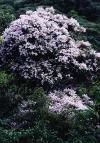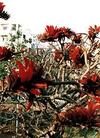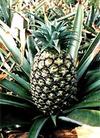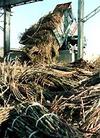Okinawa Plants
 Iju (camellia family), Shima wallichi Korthals ssp. Liukiuensis Bloemb
Iju (camellia family), Shima wallichi Korthals ssp. Liukiuensis Bloemb
An evergreen tree which can be seen growing over a wide area near seacoasts from second stage to chinquapin forests It blooms with a pale yellow flower during the rainy season in May and June and the blooms add a touch of brightness to the rainy forest.
 Aobana hainoki (hai family), Symplocos likiuensis Matsum
Aobana hainoki (hai family), Symplocos likiuensis Matsum
A fairly tall evergreen which grows in the mountains. It blooms with a beautiful pale purple flower in March and April.

 Okinawa Sekkoku, Dendrobium okinawense (Critically Endangered, Red Data Book of Japan)
Okinawa Sekkoku, Dendrobium okinawense (Critically Endangered, Red Data Book of Japan)
Orchidaceae. A rare orchid in the forest of Yanbaru which grows on trunks and thick branches. A drooping stalk and an exceptionally large flower are distinctive features of this orchid.
 Koke-tanpopo, Solenogyne mikadoi (Vulnerable, Red Data Book of Japan)
Koke-tanpopo, Solenogyne mikadoi (Vulnerable, Red Data Book of Japan)
A plant of the chrysanthemum family. Its distribution is limited to northern Okinawa and several rivers on Iriomote Island. Seen on midstream rocks.
 Deigo, The blossom of the deigo tree, originally from India, was designated the prefectural flower in 1967. During the period between March and May, the large, red petals of the deigo flower stand out against blue skies. Although deigo trees can be seen throughout the prefecture, those in Sashiki Village in southern Okinawa are especially large and old. Aged about 200 years, the trees of Sashiki during May sprout deep red flowers that spread to form a floating crimson sea. The deigo blossoms on Yonaguni Island are also a spectacular site.
Deigo, The blossom of the deigo tree, originally from India, was designated the prefectural flower in 1967. During the period between March and May, the large, red petals of the deigo flower stand out against blue skies. Although deigo trees can be seen throughout the prefecture, those in Sashiki Village in southern Okinawa are especially large and old. Aged about 200 years, the trees of Sashiki during May sprout deep red flowers that spread to form a floating crimson sea. The deigo blossoms on Yonaguni Island are also a spectacular site.
The trunk and roots of the deigo do not necessarily grow straight, and woe to the person who grows the tree too close to a building or wall, for the deigo is known to cause cracks. This is the masculine quality of the tree, its power to grow. On the other hand, its blossoms give it a passionate feminine quality.
Another aspect of the deigo is that it is used to make traditional Ryukyuan lacquerware. It is said that the secret of Ryukyuan lacquerware is hidden in the quality of the deigo tree.
 Pineapple, The Okinawan Islands are a source of fruits such as pineapples, bananas, mangos and papa-yas because only Okinawa has sub tropical weather in Japan. The tropical fruit industry is the largest agricultural industry in terms of making money in Okinawa.
Pineapple, The Okinawan Islands are a source of fruits such as pineapples, bananas, mangos and papa-yas because only Okinawa has sub tropical weather in Japan. The tropical fruit industry is the largest agricultural industry in terms of making money in Okinawa.
Pineapple was once the leading tropical fruit exported to mainland Japan. Large pineapple farms were located in northern Okinawa and Yaeyama. Particularly, Motobu Town, Higashi Village, and Ishigaki City produced a large amount of pineapples.
One theory notes that the first pineapple was brought by Mr. Kanjo Asabushi, the head of the Northern Region of Okinawa Islands, from the Ogasawara Islands in 1888. There is another theory that a ship from the Netherlands brought pineapples to Ishigaki Island. For business, Mr. Senyu Kakazu of Izumi, Motobu Town imported seeds from Taiwan in 1930. Therefore, Motobu and Ishigaki were the seeds of the pineapple industry.
The pineapple industry developed year after year until the early 1980s. It grew to become the second largest agricultural industry behind sugarcane. However, due to the government’s decision to apply the free trade system to the pineapple industry, it gradually became smaller and smaller.
As pineapples are still a rare fruit for mainlanders, farmers try to plan and produce quality pineapples to attract visitors from the mainland. One pineapple company shows how pineapples are picked, sliced, and made into juice.
The pineapple industry recovered by taking a new business approach, from agricultural fruits to tourist fruits. Pineapple wine and pineapple cake are other attractive products from the fruit.
 Mangrove trees: Mangroves are tropical trees that can be seen only on the islands of Okinawa in Japan. They grow in estuaries where ocean water meets the rivers. Okinawa previously had many mangrove areas, but due to polluted water, there are fewer places where mangrove shrubs can be seen. Locations where the mangrove is still plentiful are the Nakama and the Urauchi rivers in Iriomote, the Miyara River in Ishigaki, the Gesashi River in Higashi Village and the Kanna River in Ginoza Village.
Mangrove trees: Mangroves are tropical trees that can be seen only on the islands of Okinawa in Japan. They grow in estuaries where ocean water meets the rivers. Okinawa previously had many mangrove areas, but due to polluted water, there are fewer places where mangrove shrubs can be seen. Locations where the mangrove is still plentiful are the Nakama and the Urauchi rivers in Iriomote, the Miyara River in Ishigaki, the Gesashi River in Higashi Village and the Kanna River in Ginoza Village.
Under the mangrove forests, an environment is provided for the growth of plankton, which begins the food chain as they are eaten by fish. Mangroves also protect the seas by filtering out eroded soil carried by rivers, and they act as a buttress against strong tidal motion. People living in tropical areas are becoming more aware of losing their natural treasure, the mangrove. The loss of its beneficial effects may hurry the destruction of the environment.
An International Association for Researching the Ecology of the Mangrove was established in Okinawa in 1992 by scientists and preservationists from around the world. With the association’s office located at the University of the Ryukyus, Okinawa is taking part in environmental protection.
 Sugarcane: As Okinawa experiences the cold chills of its version of winter in late January, it is the harvest time for sugarcane, the main agricultural crop. Having the only subtropical climate in Japan conducive to growing sugarcane, Okinawa also has its crop subsidized by the national government, going against the international trend to open up markets to free trade. At one time Kadena Air Base and Camp Hansen in Kin were rich sugarcane fields.
Sugarcane: As Okinawa experiences the cold chills of its version of winter in late January, it is the harvest time for sugarcane, the main agricultural crop. Having the only subtropical climate in Japan conducive to growing sugarcane, Okinawa also has its crop subsidized by the national government, going against the international trend to open up markets to free trade. At one time Kadena Air Base and Camp Hansen in Kin were rich sugarcane fields.
Even with subsidization, the number of households cultivating the crop decreases yearly, and the size of fields has become smaller because of housing and resort construction.
Planting and harvesting sugarcane is back-breaking work, so young people are not likely to take it up. It has been popularly stated that the young are averse to work involving the 3k’s in Japanese—kitsui, kitanai, kiken ( 3d’s in English—distasteful, dirty, dangerous). Nevertheless it is a labor-intensive activity that is mainly done by older men and women, and farmers engaging in this industry usually find themselves shorthanded. In the past, laborers from Taiwan and Korea were employed.
Nowadays groups from the mainland are organized in Tokyo to come down to help cut the cane, and in doing so learn the ways of Okinawan farmers, and experience a life different from their own urban background. There also is almost always a group of U.S. soldiers, doing their part to perform community work and to communicate with the local people, to help the farmers.
One of the scenes of Okinawa’s winter is a field of tall, white-topped sugarcane, ready to be cut down and taken to processing plants to be turned into tasty brown sugar, a traditional treat, but that is another story.
